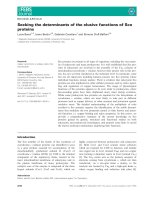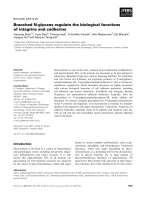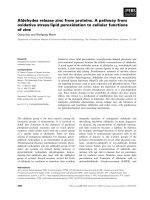Functions
Bạn đang xem bản rút gọn của tài liệu. Xem và tải ngay bản đầy đủ của tài liệu tại đây (266.13 KB, 78 trang )
2003 Prentice Hall, Inc. All rights reserved.
1
Chapter 3 - Functions
Outline
3.1 Introduction
3.2 Program Components in C++
3.3 Math Library Functions
3.4 Functions
3.5 Function Definitions
3.6 Function Prototypes
3.7 Header Files
3.8 Random Number Generation
3.9 Example: A Game of Chance and Introducing enum
3.10 Storage Classes
3.11 Scope Rules
3.12 Recursion
3.13 Example Using Recursion: The Fibonacci Series
3.14 Recursion vs. Iteration
3.15 Functions with Empty Parameter Lists
2003 Prentice Hall, Inc. All rights reserved.
2
Chapter 3 - Functions
Outline
3.16 Inline Functions
3.17 References and Reference Parameters
3.18 Default Arguments
3.19 Unary Scope Resolution Operator
3.20 Function Overloading
3.21 Function Templates
2003 Prentice Hall, Inc. All rights reserved.
3
3.1 Introduction
• Divide and conquer
– Construct a program from smaller pieces or components
– Each piece more manageable than the original program
2003 Prentice Hall, Inc. All rights reserved.
4
3.2 Program Components in C++
• Modules: functions and classes
• Programs use new and “prepackaged” modules
– New: programmer-defined functions, classes
– Prepackaged: from the standard library
• Functions invoked by function call
– Function name and information (arguments) it needs
• Function definitions
– Only written once
– Hidden from other functions
2003 Prentice Hall, Inc. All rights reserved.
5
3.3 Math Library Functions
• Perform common mathematical calculations
– Include the header file <cmath>
• Functions called by writing
– functionName(argument1, argument2, …);
•Example
cout << sqrt( 900.0 );
– sqrt (square root) function The preceding statement would
print 30
– All functions in math library return a double
2003 Prentice Hall, Inc. All rights reserved.
6
3.3 Math Library Functions
• Function arguments can be
– Constants
• sqrt( 4 );
–Variables
• sqrt( x );
– Expressions
• sqrt( sqrt( x ) ) ;
• sqrt( 3 - 6x );
2003 Prentice Hall, Inc. All rights reserved.
7
Method Description Example
ceil( x )
rounds x to the sm allest integer
not less than x
ceil( 9.2 )
is
10.0
ceil( -9.8 )
is
-9.0
cos( x )
trigonometric cosine of x
(x in radians)
cos( 0.0 )
is
1.0
exp( x )
exponential function ex
exp( 1.0 )
is
2.71828
exp( 2.0 )
is
7.38906
fabs( x )
absolute value of x
fabs( 5.1 )
is
5.1
fabs( 0.0 )
is
0.0
fabs( -8.76 )
is
8.76
floor( x )
rounds x to the largest integer
not greater than x
floor( 9.2 )
is
9.0
floor( -9.8 )
is
-10.0
fmod( x, y )
rem ainder of x/y as a floating-
point number
fmod( 13.657,
2.333 )
is
1.992
log( x )
natural logarithm of x (base e)
log( 2.718282 )
is
1.0
log( 7.389056 )
is
2.0
log10( x )
logarithm of x (base 10)
log10( 10.0 )
is
1.0
log10( 100.0 )
is
2.0
pow( x, y )
x raised to pow er y (xy)
pow( 2 ,
7 )
is
128
pow( 9 , .5 )
is
3
sin( x )
trigonometric sine of x
(x in radians)
sin( 0.0 )
is
0
sqrt( x )
square root of x
sqrt( 900.0 )
is
30.0
sqrt( 9.0 )
is
3.0
tan( x )
trigonometric tangent of x
(x in radians)
tan( 0.0 )
is
0
Fig . 3.2 M a th lib ra ry func tio ns.
2003 Prentice Hall, Inc. All rights reserved.
8
3.4 Functions
• Functions
– Modularize a program
– Software reusability
• Call function multiple times
• Local variables
– Known only in the function in which they are defined
– All variables declared in function definitions are local
variables
• Parameters
– Local variables passed to function when called
– Provide outside information
2003 Prentice Hall, Inc. All rights reserved.
9
3.5 Function Definitions
• Function prototype
– Tells compiler argument type and return type of function
– int square( int );
• Function takes an int and returns an int
– Explained in more detail later
• Calling/invoking a function
– square(x);
– After finished, passes back result
2003 Prentice Hall, Inc. All rights reserved.
10
3.5 Function Definitions
• Format for function definition
return-value-type function-name( parameter-list )
{
declarations and statements
}
– Parameter list
• Comma separated list of arguments
– Data type needed for each argument
• If no arguments, use void or leave blank
– Return-value-type
• Data type of result returned (use void if nothing returned)
2003 Prentice Hall, Inc. All rights reserved.
11
3.5 Function Definitions
• Example function
int square( int y )
{
return y * y;
}
• return keyword
– Returns data, and control goes to function’s caller
• If no data to return, use return;
– Function ends when reaches right brace
• Control goes to caller
• Functions cannot be defined inside other functions
• Next: program examples
2003 Prentice Hall, Inc. All rights reserved.
12
3.6 Function Prototypes
• Function prototype contains
– Function name
– Parameters (number and data type)
– Return type (void if returns nothing)
– Only needed if function definition after function call
• Prototype must match function definition
– Function prototype
double maximum( double, double, double );
– Definition
double maximum( double x, double y, double z )
{
…
}
2003 Prentice Hall, Inc. All rights reserved.
13
3.6 Function Prototypes
• Function signature
– Part of prototype with name and parameters
• double maximum( double, double, double );
• Argument Coercion
– Force arguments to be of proper type
• Converting int (4) to double (4.0)
cout << sqrt(4)
– Conversion rules
• Arguments usually converted automatically
• Changing from double to int can truncate data
– 3.4 to 3
Function signature
2003 Prentice Hall, Inc. All rights reserved.
14
3.6 Function Prototypes
Data types
long double
double
float
unsigned long int (synonymous with unsigned long)
long int (synonymous with long)
unsigned int (synonymous with unsigned)
int
unsigned short int
(synonymous with
unsigned short
)
short int
(synonymous with
short
)
unsigned char
char
bool
(
false
becomes 0,
true
becomes 1)
Fig. 3.5 Promotion hierarchy for built-in data types.
2003 Prentice Hall, Inc. All rights reserved.
15
3.7 Header Files
• Header files contain
– Function prototypes
– Definitions of data types and constants
• Header files ending with .h
– Programmer-defined header files
#include “myheader.h”
• Library header files
#include <cmath>
2003 Prentice Hall, Inc. All rights reserved.
16
3.8 Random Number Generation
• rand function (<cstdlib>)
– i = rand();
– Generates unsigned integer between 0 and RAND_MAX
(usually 32767)
• Scaling and shifting
– Modulus (remainder) operator: %
• 10 % 3 is 1
• x % y is between 0 and y – 1
–Example
i = rand() % 6 + 1;
• “Rand() % 6” generates a number between 0 and 5 (scaling)
• “+ 1” makes the range 1 to 6 (shift)
– Next: program to roll dice
2003 Prentice Hall, Inc. All rights reserved.
17
3.8 Random Number Generation
•Next
– Program to show distribution of rand()
– Simulate 6000 rolls of a die
– Print number of 1’s, 2’s, 3’s, etc. rolled
– Should be roughly 1000 of each
2003 Prentice Hall, Inc. All rights reserved.
18
1 // Fig. 3.8: fig03_08.cpp
2 // Roll a six-sided die 6000 times.
3 #include <iostream>4
5 using std::cout;
6 using std::endl;7
8 #include <iomanip>
9 using std::setw;
11 #include <cstdlib> // contains function prototype for rand
14 int main() {
16 int frequency1 = 0;
17 int frequency2 = 0;
18 int frequency3 = 0;
19 int frequency4 = 0;
20 int frequency5 = 0;
21 int frequency6 = 0;
22 int face; // represents one roll of the die
2003 Prentice Hall, Inc. All rights reserved.
19
24 // loop 6000 times and summarize results
25 for ( int roll = 1; roll <= 6000; roll++ ) {
26 face = 1 + rand() % 6; // random number from 1 to 6
28 // determine face value and increment appropriate counter
29 switch ( face ) {
31 case 1: // rolled 1
32 ++frequency1;
33 break;
35 case 2: // rolled 2
36 ++frequency2;
37 break;
39 case 3: // rolled 3
40 ++frequency3;
41 break;
43 case 4: // rolled 4
44 ++frequency4;
45 break;
47 case 5: // rolled 5
48 ++frequency5;
49 break;
2003 Prentice Hall, Inc. All rights reserved.
20
51 case 6: // rolled 6
52 ++frequency6;
53 break;
55 default: // invalid value
56 cout << "Program should never get here!";
58 } // end switch
60 } // end for
62 // display results in tabular format
63 cout << "Face" << setw( 13 ) << "Frequency"
64 << "\n 1" << setw( 13 ) << frequency1
65 << "\n 2" << setw( 13 ) << frequency2
66 << "\n 3" << setw( 13 ) << frequency3
67 << "\n 4" << setw( 13 ) << frequency4
68 << "\n 5" << setw( 13 ) << frequency5
69 << "\n 6" << setw( 13 ) << frequency6 << endl;
71 return 0; // indicates successful termination
73 } // end main
2003 Prentice Hall, Inc. All rights reserved.
21
Face Frequency
1 1003
2 1017
3 983
4 994
5 1004
6 999
2003 Prentice Hall, Inc. All rights reserved.
22
3.8 Random Number Generation
• Calling rand() repeatedly
– Gives the same sequence of numbers
• Pseudorandom numbers
– Preset sequence of "random" numbers
– Same sequence generated whenever program run
• To get different random sequences
– Provide a seed value
• Like a random starting point in the sequence
• The same seed will give the same sequence
– srand(seed);
• <cstdlib>
• Used before rand() to set the seed
2003 Prentice Hall, Inc. All rights reserved.
23
1 // Fig. 3.9: fig03_09.cpp
2 // Randomizing die-rolling program.
3 #include <iostream>
5 using std::cout;
6 using std::cin;
7 using std::endl;
9 #include <iomanip>
11 using std::setw;
13 // contains prototypes for functions srand and rand
14 #include <cstdlib>
16 // main function begins program execution
17 int main() {
19 unsigned seed;
21 cout << "Enter seed: ";
22 cin >> seed;
23 srand( seed ); // seed random number generator
2003 Prentice Hall, Inc. All rights reserved.
24
25 // loop 10 times
26 for ( int counter = 1; counter <= 10; counter++ ) {
28 // pick random number from 1 to 6 and output it
29 cout << setw( 10 ) << ( 1 + rand() % 6 );
31 // if counter divisible by 5, begin new line of output
32 if ( counter % 5 == 0 )
33 cout << endl;
35 } // end for
37 return 0; // indicates successful termination
39 } // end main
Enter seed: 67
6 1 4 6 2
1 6 1 6 4
Enter seed: 67
6 1 4 6 2
1 6 1 6 4
2003 Prentice Hall, Inc. All rights reserved.
25
3.8 Random Number Generation
• Can use the current time to set the seed
– No need to explicitly set seed every time
– srand( time( 0 ) );
– time( 0 );
• <ctime>
• Returns current time in seconds
• General shifting and scaling
– Number = shiftingValue + rand() % scalingFactor
– shiftingValue = first number in desired range
– scalingFactor = width of desired range









